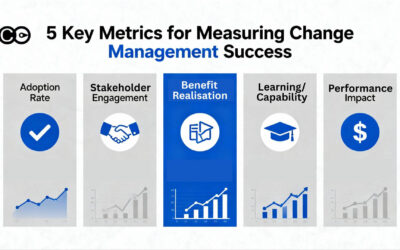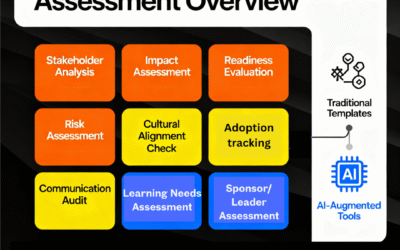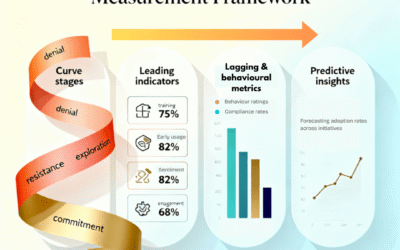The term “single view of change” is starting to gain more popularity and organisations are starting to understand why they need this and what it looks like. The term refers to an artifact that shows the different change initiatives being mapped together. This is usually presented in a calendar format that shows when the initiatives will impact the organisation over time. In this article, we will look closely at what the single view of change is, what stakeholders are looking for in this artifact and how to use it.
Typical formats for single view of change
- Red, amber and green cells for each project across time
- Business unit based heatmap across time
Here are some examples from The Change Compass as reference.
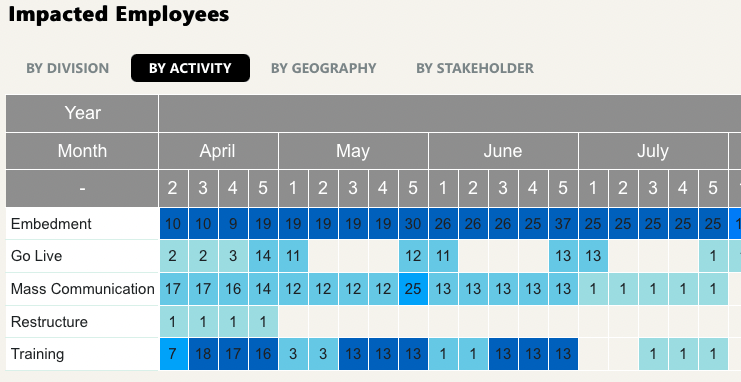
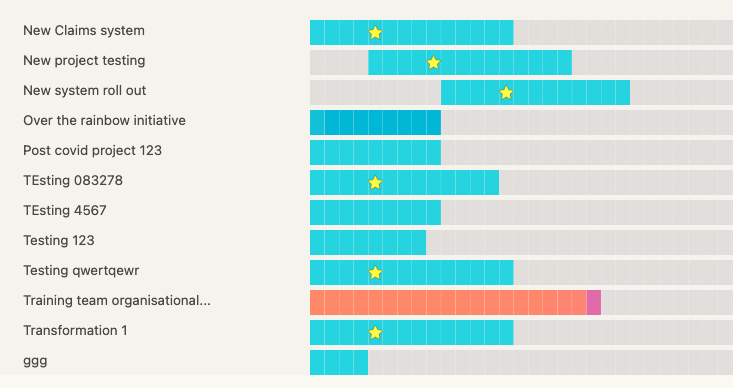
To read up more about Heatmap formats and what to look out for read Why Heatmaps are not the bet way to make change decisions.
Recent trends
In the past year there has been increasing interest from organisations talking about single view of change (SVOC) and wanting to derive this view. What we’ve observed at The Change Compass are the following trends:
- Senior managers or executives are often the ones who are requesting the SVOC.
- This usually arises as the number of change initiatives starts to increase and there is feedback that there could be too much change for employees to handle or change fatigue. This is not a surprise given the companies are already struggling to keep up with competitive, technology, and regulatory changes. Covid has added to these changes and compounded the overall change load.
- Senior managers are after data to make decisions on. And managing change is no exception. Gone are the days when managers can make decisions based on opinions and hunches. With Covid, there are employees working remotely and so performance needs to be managed based on data – there is simply no other way. In a similar vein, change data is integral to making business decisions.
An example of stakeholders requesting SVOC
When I was the Head of Change at National Australia Bank there was a strong focus on deriving a single view of change. This was not always the case. There were constant complaints from employees that there was too much change. On the other hand, senior managers often responded with “we’re still able to run the business and the business has not broken, so let’s keep going”.
One of the key reasons that senior managers were requesting SVOC was that initiatives are by design in silos. Each initiative team designs the initiative independent of other initiatives. From a technical perspective, there are various architects who are accountable for advising on what the technology stack should look like and what is in the best interest of the organisation across initiatives. However, from a people change perspective there were no practices in which changes across the board are harmonised and sequenced.
Eventually, at National Australia Bank we built a clunky way of capturing change impact data that did meet stakeholder needs. My realisation was that stakeholders that request SVOC were not after the artifacts per se. In fact what they were after most were:
- Determining when there would be too much change saturation leading to change fatigue
- Ability to determine what needs to be moved and how/when initiatives can be moved if there is contention
- Understanding key risks that could arise in executing on a range of change initiatives that could disrupt the business or impact initiative benefit realisation
- Understanding what change activities are organised and how they are impacting business-as-usual operations so that effective resourcing can be in place
What this means is that stakeholders are asking for SVOC, when they are really asking for a way to manage the change portfolio in a way that reduces risk for the organisation and maximise benefits targeted. Managing change at a portfolio level is a new concept and discipline for most organisations.
Change portfolio management takes time and capability to evolve and grow into in each organisation. To read up more about how to manage a change portfolio read The Ultimate Guide to Change Portfolio Management and How to Better Manage a Change Portfolio Infographic.

Lessons learnt across different organisations
Over the years in working with organisations through The Change Compass, I’ve noticed the following trends across different organisations when it comes to creating and using SVOC.
- Change saturation can mean different things to different stakeholders. This reflects on the different parts of change management focus areas for organisations. Some focus on the humanistic aspects of change for individuals. This includes the personal experience and stress of change fatigue. Others focus on the impacts of business performance and resourcing.
- Some of the presented reasons for change saturation
- “Our employees tell us there is too much change”. This needs to be carefully considered when providing feedback to senior managers. Some could be skeptical of the feedback and respond with comments such as “there are always complaints about too much change”. A balanced view including employee feedback as well as other business indicators would be advised. For example, efficiency levels or absenteeism.
- Not adopting a change portfolio approach – Just seeing the risks and business problems with SVOC will not necessarily resolve the issues. It is about making business decisions with the information that will create impact.
- Poor portfolio management – If this is the reason then most companies have poor portfolio management because change portfolio management is still in its infancy for most organisations.
- Responses of execs determine the outcomes – some still insist on persisting with change in the face of change saturation. From what we have seen a lot of senior managers usually learn from the aftermath of change saturation before they will make decisions to avoid it in the first place. Help your senior managers to understand the consequences and what it means to business data. Of course, the more detailed data you can provide the more convincing your argument is going to be.
- Because companies haven’t invested in people capability – Having better change capability can impact the way employees perceive and undergo the change journey. More change mature teams tends to be able to absorb more and faster changes than those who are less mature. However, change maturity takes time and investment to build and is not a lever that can be pulled overnight.
- Not effectively setting expectations and agenda for what is coming. Setting clear expectations is the first step. Without knowing what changes to expect the change outcome could be impacted. However, this is only one part of the change equation. Having achieved clarity of expectation is just the first step. There are lots of other steps to take to create an effective change journey.
- External factors affecting the load of change may not be easily filtered by the organisation. Lots of organisations are facing multiple impacts of change from different arenas, technology, regulations, competition, and other industry changes. In many cases, the changes piled on top of each other creating a significant change load that cannot be easily moved out. In this case, organisations need to be realistic about what can be achieved given this load of change. Would investing in capability help to lift the ability to undergo a heightened change volume? Can we package changes so that they are more streamlined and integrated, and thereby reducing cognitive load for impacted employees?

The role of change practitioners
Through using a SVOC change practitioners can play different roles in adding value to the organisation.
- Change portfolio management: Managing a portfolio from a change impact perspective is a role that can add significant value. The benefits of adopting a portfolio approach can result in initiatives being harmonised. From the user perspective, changes are better linked and grouped versus being isolated from each other.
- Architecting and designing delivery: With better alignment and synchronisation, initiative rollout can be better designed as a whole, with a convincing set of strategies and themes that make sense for impacted employees.
- Executive consultation and influencing: Armed with data it is much easier to influence senior executives. The trick is to select the few data visualisations that tell the story of key risks to the organisation, and the size of the problems involved. This also needs to be paired with recommended solutions.
- Business change capability building – With SVOC change capability building is not just about rolling out generic skills, but targeted content delivered at the right junctures to equip the business with the right skills to be better equipped for a targeted set of changes
Next steps
Are you working on a SVOC? Do you have questions? If you would like to talk to us to understand how others have fared in their SVOC journeys click the following button to book time. We’re happy to share with you some of the tips and tricks in deriving SVOC.




